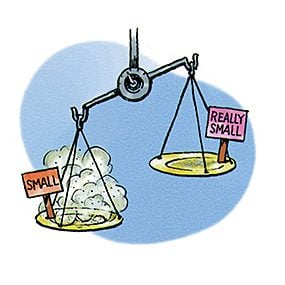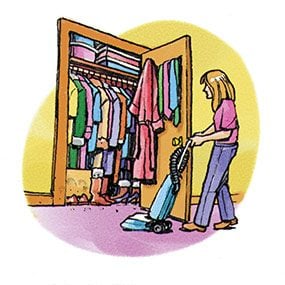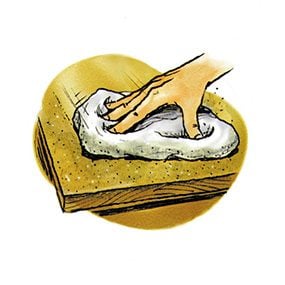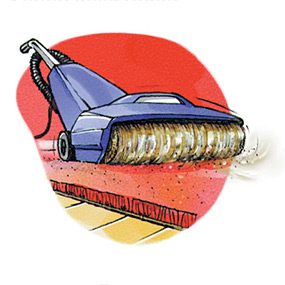How to Get Rid of Dust
Updated: Feb. 06, 2023Keep your family safe from allergens—and from an unsightly gray film covering everything
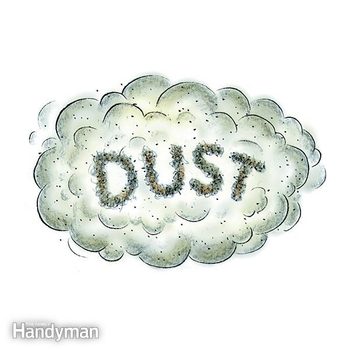
Household dust
Although you can beat back the general household dust invasion, dust will never go away. Wipe it up one week and by the next, a fine gray film has settled on the picture frames and mantel, and dust bunnies are scurrying around under the bed. No one yet has found the magic that’ll make dust disappear, particularly airborne dust. Hardware improvements such as vacuums with better filtration and whole-house air cleaners can make the job a bit easier, but dusting is still a weekly chore. And frankly, we don’t have any revolutionary ideas either. The basic solution is pretty much the same as grandma taught—clean, clean, clean. But it’s important to know whether you should dust or vacuum first.
However, if you target the key places where dust collects and deal with it before it goes airborne, you can at least put a damper on dust. In this article, we’ll tell you where dust originates and where it builds up, so you can focus your cleaning efforts on those spots.
First—what is dust?
For practical purposes, household dust fits into two categories: small stuff and really small stuff (Fig. A).
The small stuff is the stuff that bugs you. It’s that gray fluff that you see piled up in corners, on bookshelves, and under the couch. The vast bulk of it, more than 90 percent in most homes, is composed of just two materials, dead skin flakes and fabric fibers. The human body continuously sheds skin, dramatically when you have a sunburn, yet almost constantly in the form of tiny particles. The fabric fibers are also small, the same lint that you collect on the dryer screen. These particles range in size from 10 to 300 microns (1 micron equals 1/1000th of a millimeter). If you have sharp eyes, you can just barely see a 20-micron fabric filament floating in a shaft of sunlight that’s streaming through the window. In comparison, the typical hair caught in your hairbrush is about 100 microns thick.
Other small dust contributors range from human and pet hair to soil particles, pollen, mildew spores, dust mites and other minor sources. The dust in some homes also contains debris from localized concentrations of cockroaches, termites, ants or other insects. (My home, with its never-ending do-it-yourself projects, has a higher than normal concentration of drywall dust and sawdust!)
You can’t see the really small stuff, particles smaller than 10 microns, unless they collect in high concentrations. So even though your home contains millions of these particles (they make up 99 percent of all dust particles), they’re so small that they won’t contribute much to the visible dust invasion.
But really small dust can affect your health. Debris from dust mites and insects, cat and other animal dander and smaller plant spores and pollen often cause allergies. Paint pigments, including the lead oxide used in many paints before 1978, also fall into this really small category too. Lead dust is the principal cause of lead poisoning in children.
If you have a dust-related health problem, don’t try expensive home remedies until you’ve consulted a physician. Dust control strategies for really small particles are difficult and can be costly if you have to replace carpeting with a different floor covering or buy a special vacuum cleaner. Your physician will help you discover the particular offender so you can target your control strategies, rather than attack all types of dust. We’ll mention some strategies for dealing with allergy-causing particles below, but not in detail.
You can’t stop major dust sources
The major components of dust fall off human beings and fabrics such as clothing, furniture, drapes and carpets. Since you’re not likely to banish the kids and your spouse to the garage or live a life free of fabric, you can’t stop the main dust-producers at their sources. Rather, you have to use good housecleaning techniques to attack dust where it builds up and spreads.
Better housecleaning strategy
Here are the basics: Vacuum carpets and shake out rugs weekly. Wall-to-wall carpeting is a world-class dust-collector, and it launches particles back into the air every time you walk across it (Fig. B). It’s virtually impossible to clean. Vacuuming helps, but it’s like trying to suck up all the leaves from a forest. It’s easier to clean area rugs, because you can shake or beat them outside or periodically send them to the cleaners. Frequent vacuuming of busy pathways won’t eliminate dust, but it’ll cut down the volume. And it will reduce the sand particles that abrade the carpet fibers and cause them to break down. Regularly vacuum furniture cushions and pillows. Like carpeting, they create, collect and spew dust into the air whenever you sit down on them.
Clean bedrooms weekly, since you probably spend more time there than in any other room in the house. Skin flakes especially collect in the bedding, and bedding and clothing contribute fabric dust too. Regular laundering will help keep the dust down. Alert: If you suffer from allergies, bedrooms rank at the top of the list for dust control.
They’re easy to ignore, so clothes closets collect dust too. Clothing steadily sheds filaments, and every time you open and shut the door and pull out clothing and shoes, air turbulence launches that dust into the air. Dust particles work their way downward, so a closet floor that’s free of shoes and other clutter makes for quick, more effective vacuuming.
We haven’t mentioned the most obvious dust collection spots—for example, under beds and furniture, and behind the stove and refrigerator. It’s true that dust settles in these areas out of sight, but once it’s settled, it usually sits there undisturbed. Although it pays to clean those areas periodically, they won’t contribute much visible dust to active living areas of your home. Clean them regularly, however, if you have allergies, because dust mites can thrive there.
Stop secondary dust sources
You probably blame the kids, but everyone constantly tracks in dirt from the outdoors. Most drops off within 15 ft. of an entry door, so a rug just inside the door and a mat outside will collect most dirt right there at the entry.
Hair and other dust from dogs, cats and birds will spread throughout a house. No control strategy works well. If you have allergies, you might have to find a new home for your pets.
Dust mites live in almost every home, because they like a warm, humid environment with lots of skin flakes to eat. They’d be disgusting if they weren’t so tiny, an almost invisible speck 250 microns in size. They sometimes proliferate in bedding and other moist areas and contribute their outer shells and other debris to the general dust level. In most cases they aren’t a problem and are easily controlled by laundering bedding and vacuuming regularly.
However, dust mites often cause allergies. If a physician determines that you have a dust mite allergy, simple control methods include laundering bedding in 130-degree water and maintaining a relative humidity level below 60 percent through air conditioning or dehumidification. The dust mites will soon dry up and die. For persistent problems, your physician will direct you to specialized (and more expensive) dust mite control methods, like special bedding, carpet removal, and higher efficiency vacuums. (One mail-order source for these products is Allergy Control Products, Inc. Call 800-255-3749—800-255-ALLERGY—for a free catalog.)
Mold and mildew release thousands of tiny spores that contribute to localized dust, create bad odors and sometimes cause allergic reactions. Mold and mildew are microscopic fungi that live in huge colonies in damp areas. The colonies look like dark smudges and can be found in corners, on the grout in bathroom tile and especially under carpeting in damp areas like basements. Control mildew and mold by eliminating the moisture supply by such means as dehumidification, exhaust fans in bathrooms, better foundation drainage, and sealing concrete floors or removing carpeting. You can kill existing mold and mildew by washing the area with a mixture of 1 part liquid bleach to 10 parts water (wear plastic gloves and eye protection).
Finally, keep an eye out for black soot stains on walls, the TV screen or the carpet under doors. They signal a dangerous combustion leakage from kerosene heaters, the water heater, furnace or fireplace.
Basic dust-control tools
How to Get Rid of Dust on Hard Surfaces
Dusting
A damp cloth is all you need to pick up dust from hard, smooth surfaces. (Not wet, because water left behind carries dirt and can ruin the finish on fine furniture.) The dust sticks to the cloth rather than flying around and spreading. Mops and cloths and lamb’s wool dusters with electrostatic charges also work well.
Dust loves clutter. Clutter demoralizes even a veteran housecleaner by increasing the time and effort involved. Store stuff you’re not using, and enclose knickknacks in showcases. Keep stuff off the floor.
How to Get Rid of Dust in Carpet and Furniture
Vacuuming
Use a vacuum with a beater bar for carpeting and rugs and a hose for corners, fabrics and furniture. Disposable paper bags filter better than cloth bags, usually down to about 10 microns. They’ll get most visible dust, assuming the vacuum doesn’t have leaky hoses or a loose collection system that releases dust before it gets into the bag.
On the other hand, standard vacuums are one of the worst tools for allergy sufferers, because they spew really small particles out in a huge airborne cloud through the walls of the bag. You can now buy tighter bags that filter particles down to around 1 micron and vacuums with secondary filters that collect particles down to around .3 microns. Tighter bags mean more resistance and lower suction, so most vacuums with secondary filters have better motors and cost around $200 and up. Such a vacuum is a good investment for anyone who suffers from household dust allergies.
Installing a central vacuum system is also a good investment (assuming you know that household dust is causing a health problem). You can mount the motor and collection bag in the basement or garage, so that once sucked up, even the really small particles stay out of the room. And the motors are usually powerful enough to use a high-efficiency filtration bag. The downside is the cost, $500 to over $1,000, plus installation.
How to Get Rid of Dust Floating in the Air
Air Filters
Pleated and higher efficiency furnace and air filters connected to a forced-air heating and cooling system catch a portion of airborne dust (see choosing furnace filters for more information ). They can reduce the dusting chore, but you must clean or change the filter regularly.
Required Tools for this Project
Have the necessary tools for this DIY project lined up before you start—you’ll save time and frustration.
- Rags
- Vise
